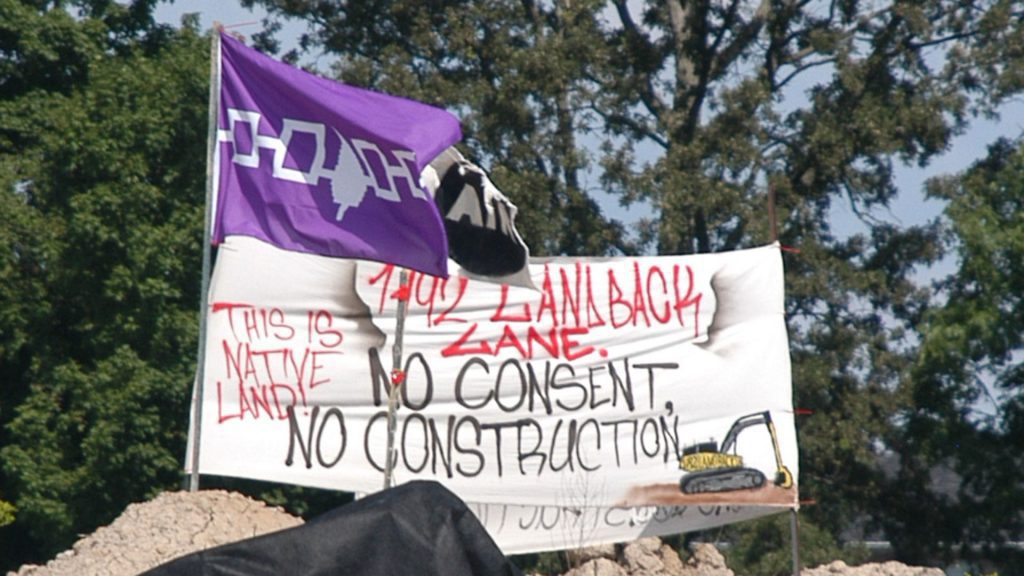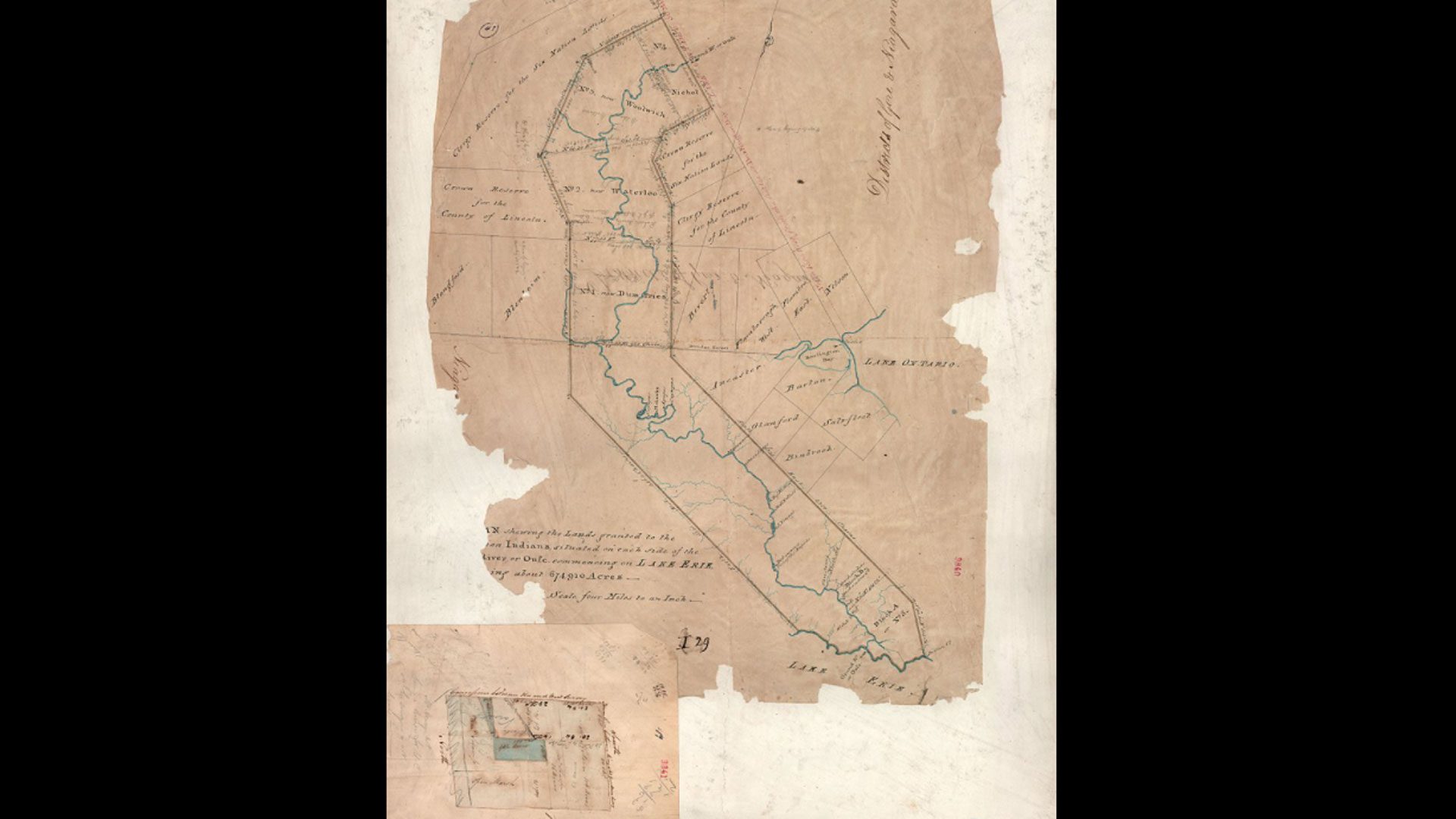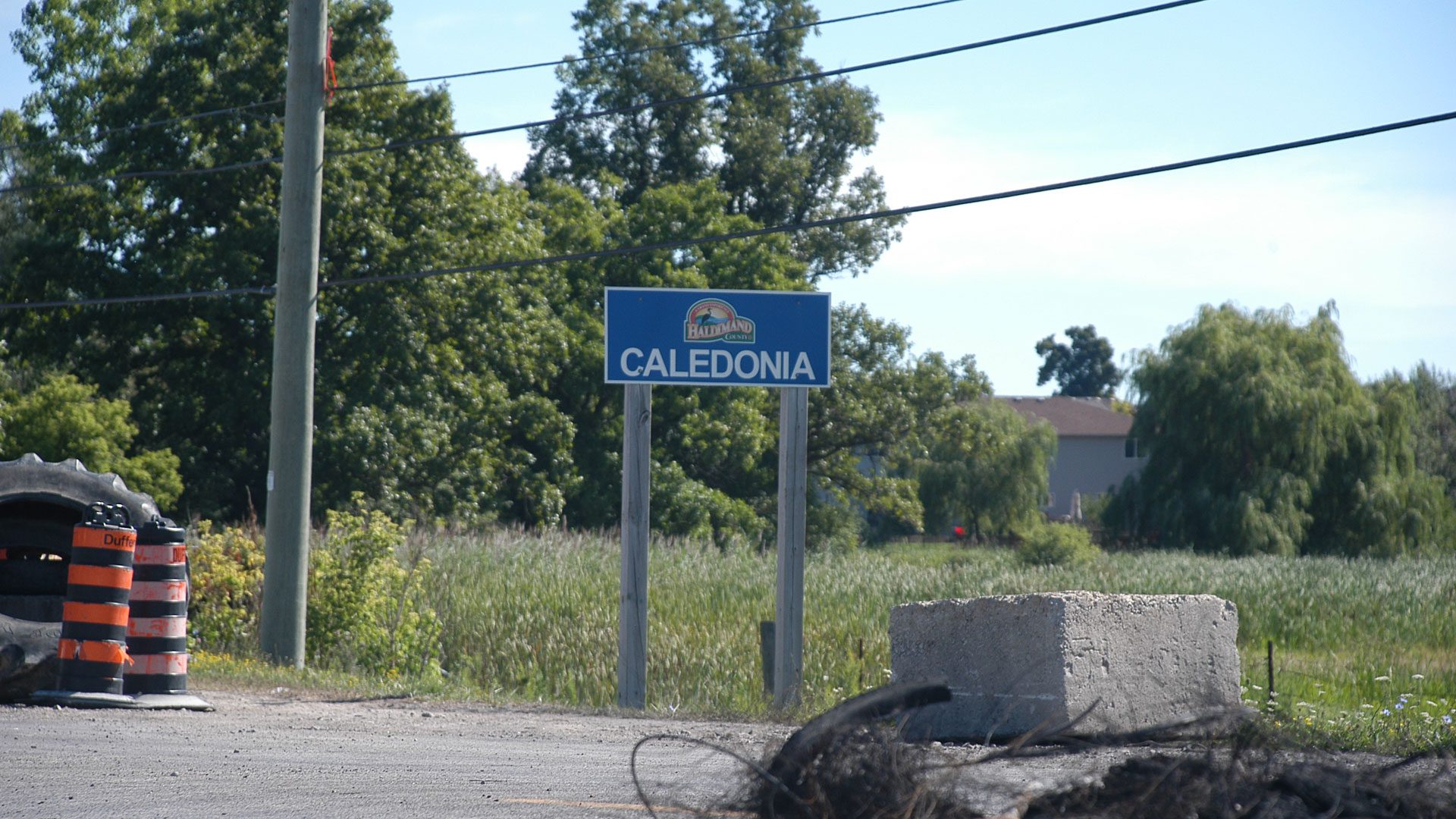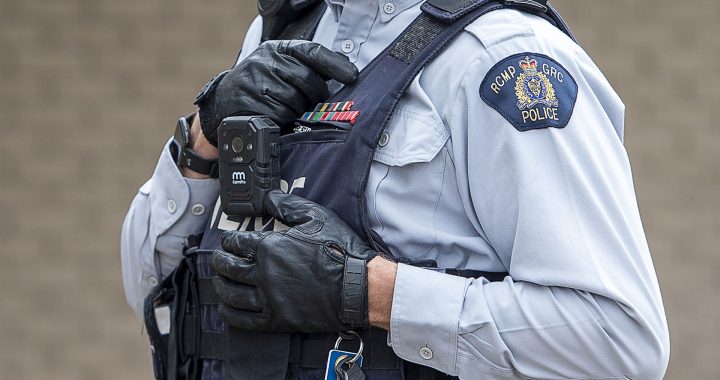
The Haudenosaunee Hiawatha Belt flag outside the now-cancelled McKenzie Meadows development in Caledonia. APTN has obtained internal documents written shortly after a police raid on the site last summer. Photo: APTN
Officials at Crown-Indigenous Relations worry the Crown may lose a lawsuit launched by Six Nations of the Grand River’s elected council over the community’s numerous outstanding land claims, internal documents suggest.
Negotiators with the Treaties and Aboriginal Government branch informed their deputy minister, the department’s top public servant, of the law department’s opinion in an August 2020 briefing package obtained by APTN News.
“The First Nation is claiming approximately 900,000 acres of land that was improperly surrendered in southwestern Ontario,” the memo explained.
“Justice Canada advises that portions of the Six Nations litigation claim poses high risk for the Crown, and will result in a significant damage award.”

Filed in 1995, the statement of claim alleges the Crown stole nearly all of the 950,000-acre Haldimand Tract from the Six Nations, also known as the Haudenosaunee or Iroquois Confederacy. The land stretches six miles from either bank of the Grand River and was granted them “to enjoy forever” in 1784.
The suit claims the Crown broke this promise and abused its trustee position by squandering, mishandling or embezzling the community’s assets.
The plaintiffs initially asked the court to force Canada and Ontario to account for all allegedly stolen cash and land. It was amended in 2020 to seek damages for breach of treaty obligations and fiduciary duty.
“Six Nations’ financial expectations are extremely high (over a trillion dollars),” the memo continued. “A judicial decision may be required to reset those expectations.”
Cash spent during 19th century
Throughout the 1800s, Crown agents gave Six Nations money to municipalities, McGill College, the Law Society of Upper Canada, the City of Toronto and others, according to a research booklet compiled by the elected council’s lands and resources department.
The Crown gave cash to utility companies that spent it on railroads, canals and other public works. Six Nations trust money was used to pay down some of Canada’s war debt.
“We’re very confident. I think we can establish without any difficulty that there was a breach of fiduciary duty,” said Lonny Bomberry, director at Six Nations lands and resources.
“A lot of the lands were taken without any legal surrenders that would stand up by the laws of the time, and some of these claims are so obvious that they cry out for resolution.”

In 1824, the Crown used Six Nations money to finance operations of the Welland Canal Company, a new Crown corporation. The company then expropriated and flooded about 2,500 acres of Haudenosaunee land.
Nothing was ever paid back, and, although legislation required it, the community was never compensated, Bomberry said.
His department’s research concluded the modern value of all allegedly misused money could be worth between $13.9 billion and $8.7 trillion depending on the rate of interest.
Feds, province fight over jurisdiction
The briefing package was among 700 pages of internal records released to APTN through an access to information request.
The material was written in August 2020 at the height of a standoff over the now-cancelled McKenzie Meadows housing development on disputed land in Caledonia a few kilometres northeast of Six Nations.
A government negotiator wrote in a previous draft that the case “poses high risk for Canada” but later changed “Canada” to “the Crown.” The official explained in an email the correction was required “to account for Ontario.”
Fighting between Ontario and Canada over jurisdictional liability hampered resolution of Six Nations’ claims 15 years ago, an independent fact finder concluded.
The Harper government sent Western University law professor Michael Coyle to Caledonia to probe the situation in 2006 after community members occupied and halted the proposed Douglas Creek Estates housing development.

Coyle’s report said Ontario and Canada could work out the issue of liability “immediately” amongst themselves, using private arbitration if needed.
“It seems equally urgent to resolve this dispute, internal to the Crown, as it is to resolve any internal disputes with the Six Nations community about how to proceed with the claims,” Coyle reported.
He continues to believe mediated negotiations are the best way to move forward, calling it “disappointing” these talks aren’t happening more than a decade later.
“From the outside, it seems like the problem just isn’t being addressed right now,” Coyle said in a phone interview. “That to me is worrisome because it seems like it slips away from public attention for years on end, and then frustrations boil over and it becomes, if anything, even more difficult to deal with in the future.”
Talks abandoned in 2018
Land claims were one of the subjects of trilateral “exploratory discussions” struck between the elected council, Canada and Ontario in 2016.
This was not long after Justin Trudeau was elected prime minister while the provincial Liberals were in power. According to the documents, the province walked away from the table in spring 2018, which was when Doug Ford was elected Ontario premier.
“They decided that they didn’t want to be parties of exploratory tables any more for whatever reason, and they left,” Bomberry said of Ontario. “That just left us with Canada.”
An Ontario spokesperson said via statement that talks wound down after contracts with facilitators expired. Ontario has continued to engage in other ways, the statement said, such as signing a $102-million deal involving a Brantford casino that occupies disputed territory.
But federal officials, though they refused to say it publicly, believed an out-of-court settlement can’t be reached unless Ontario is willing to sit down and pay up.
“A breakthrough regarding the First Nations’ claims is unlikely in the foreseeable future as it would require Canada to assume Ontario’s share of compensation and possibly seek reimbursement from the province in subsequent litigation,” officials wrote in an Aug. 7, 2020 internal memo.
At that time, Six Nations members and supporters had erected blockades on Caledonia’s streets after provincial police raided the McKenzie Meadows site, which activists occupied a few weeks earlier and renamed 1492 Land Back Lane.
Read more:
Elected chief of Six Nations tries to unify sides ahead of land claim fight
Haudenosaunee chiefs declare development moratorium across entire Haldimand Tract
Many, including the local mayor, demanded Ottawa get involved. APTN emailed Crown-Indigenous Relations in mid-August asking what Canada could or would do to help resolve the situation.
The department declined to respond, sending pre-approved media lines instead. But in reality Ottawa had no mandate to negotiate any part of the land claims and continued to point the finger.
“The truth is, even if we could comment, which we can’t, we have not prioritized the claims portion of the discussion at the table as little/no progress can be made without the participation of Ontario,” a negotiator emailed a colleague as they discussed how to answer APTN.
The official reiterated the point in a separate email chain considering how to answer an email sent by the land back group requesting a meeting.
“I’m reluctant to include a commitment to attend a future meeting as it may raise expectations that there is something we can do about the land,” the email said. “We have no active mandate to deal with any part of their claim. It seems the immediate crisis needs to be solved between Ontario, the developers and the entirety of Six Nations.
“I’m trying to dodge an outright no by not saying anything.”
Trial scheduled for 2023
Meanwhile, getting the elected council and the traditional Haudenosaunee Confederacy Chiefs Council to adopt a united front has also proved difficult, Bomberry said.
The traditional chiefs were deposed by the RCMP and replaced with a council elected under the Indian Act by order in council in 1924.
Coyle’s report recommended the Crown consider renewing its relationship with the traditional chiefs. The briefing documents admit the confederacy must be included in any long-term solution.
Canada, Ontario, the elected council and the confederacy chiefs tried to negotiate land claims after the 2006 land reclamation.
In 2007, Canada offered $125 million to settle four of the community’s 27 unresolved land claims, which was rejected. Canada then offered $26 million to settle the 197-year-old Welland Canal grievance.

The Haudenosaunee counter-offered $500 million, according to the documents. Talks fell apart in 2009 shortly after Canada replied formally that $26 million was a fair deal. The elected council then reactivated the lawsuit, which had been in abeyance during the fruitless talks.
Recent court filings show Canada and Ontario remain dug in to positions they took in 1996 in response to the lawsuit as well as following the 2006 talks.
Canada and Ontario have filed crossclaims against each other in their amended defences filed Aug. 31, 2020. Each maintains that if the Crown is held liable for pre-confederation injustices, the other government should have to pay.
Ontario contends that Ottawa should pay because the federal government has legislative jurisdiction over “Indians and lands reserved for Indians” under the Constitution.
But the federal Justice Department said Ontario should pay because revenues from the disputed lands have flowed into provincial coffers since confederation.
A trial is scheduled for 2023.









